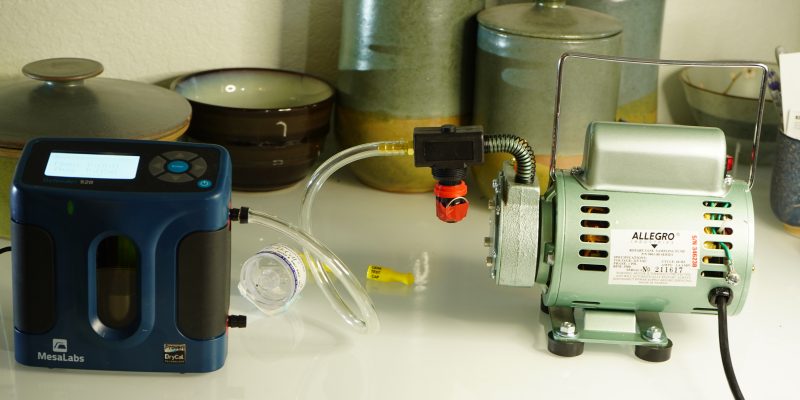Industrial Hygiene involves the recognition, evaluation and control of environmental hazards that can be inhaled, ingested or absorbed through the skin. Many of the common environmental hazards include mold, lead, asbestos, radon and chemical exposures such as solvents or heavy metals. Most of these hazards cannot be detected by sight or smell. Some of the chemicals that can be injurious to one’s health cannot be smelled until they achieve airborne concentrations above the OSHA permitted level often called the OSHA Permissible Exposure Limit or PEL. For instance, firefighters may be exposed to hazardous concentrations of chemicals long after the fire has been put out and under control. Those that install certain spray foams for insulation of buildings can become sensitized to such chemicals such that any subsequent exposure may prompt a dangerous allergic reaction. Unlike allergic reactions to things like insulation or mold, some chemicals may cause cancer with very low concentrations over an extended period. For instance, relatively low concentrations to silica or asbestos can cause irreparable lung damage, and once initiated, there is no cure. One would not notice such damage to lungs until after at least ten years of exposure. This is called the latency period. It should be noted that exposure to most hazardous agents typically affect only one or two body systems. For instance, radon exposure can only cause lung cancer and exposure to mold is known only to produce infections of the lung or upper respiratory tract and exacerbation of asthma and Chronic Obstructive Pulmonary Disease (COPD). Mold has never been known to cause cancer and radon has never been known to cause liver damage or colon cancer.
Industrial Hygienists utilize specialized equipment, filters, tubes and pumps to capture air samples and any harmful agents that may be present and subsequently breathed in. There are established methods for sampling for such harmful agents, commonly developed by the National Institute of Occupational Safety and Health. Western Engineering has a Certified Industrial Hygienist (CIH) that can measure the concentration of hazards and chemicals in the air. He has evaluated thousands of environments for toxic agents and mold. Mold is everywhere including arctic regions of the earth’s surface. Mold is one of the most adaptable of organisms, only needing a growth media, moisture and a food source to grow. Common locations that support growth are drywall, wood studs. joists or beams, and sheathing, carpeting, furniture and drapes. As most know, water is a key ingredient that supports the growth of mold. Even temporary moisture sources such as bringing snow or rain indoors on boots can help proliferate mold growth. However, most mold concentrations that become problematic indoors are caused by intermittent leaks or periodic flooding. Mold spores commonly originate outside on plants or in soil, and enter the indoor environment through air handling systems, open windows or gaps in the building envelope. Once they enter, they can remain dormant until food and or moisture is added to the system to initiate growth. The presence of mold or bacteria can be very damaging on building materials, and if not remedied quickly, can compromise the structural integrity of a building.
Ergonomics is another discipline commonly addressed by industrial hygienists. Ergonomics is the science of work and how the worker interfaces with their environment to accomplish tasks. The principle risk factors to prompt cumulative trauma injuries are excessive force, repetition and awkward postures. Combining two or more of these risk factors escalates the risk of injury such as picking up heavy items without bending the legs or carrying items or applying force well away from one’s torso. The body, like a lever, is built to provide a mechanical advantage if used properly. Ergonomics seeks to create favorable interfaces between a person and the accomplishment of a task, making it far easier to utilize good body mechanics to perform the desired task. Ergonomic chairs are a prime example, providing several adjustable settings to fit the chair to the user, including adjustable sitting height and armrests. Also, an adjustable backrest can assist the user to maintain the natural curvature of the back, especially the lumbar region. Position of the mouse and keyboard can also minimize the biomechanical stress on computer users. WERC has a Certified Ergonomic Assessment Specialist Level III on staff to address ergonomic concerns and those involving cumulative trauma and sudden trauma injuries.
Industrial Hygienists and Safety Professionals are often involved in accident investigations, especially those involving personal injuries. They are skilled in assessing the components that lead to the final and injurious result, otherwise known as the root causes of the accident. There are myriads of factors that can contribute to unsafe conditions and eventual injuries. Some of the factors that may contribute to the cause of slip and fall injuries are lighting and glare, carrying items that could obscure view, friction of the ground or floor surfaces, footwear, and transitions and contrast from one level to another. WERC has a Certified Safety Professional and experienced Professional Engineers to determine the causes of personal injuries and suggest remedies to prevent further injuries from occurring.
